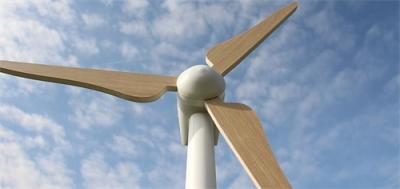Researchers in Germany are developing durable thermoplastic foams and composites that could make turbine blades lighter, and they believe that, as offshore turbines get larger, the technology could make transportation, installation, disassembly and disposal of turbine blades easier
An EU-funded project due to be completed early in 2017, is investigating the application of new, lightweight materials that could be used in the next generation of blades for offshore wind turbines. The participants in the project – the Fraunhofer Institute for Chemical Technology ICT, Smithers Rapra, Windrad Engineering, Loiretech, PPG Industries Fiber Glass, Norner Research, Coriolis Composites, NEN, TNO and COMFIL – believe that thermoplastic sandwich materials of the type they are working on could have a number of advantages. They note the trend towards ever larger offshore wind turbines means that rotor blades are also getting larger and larger, and heavier and heavier. Current blades can be 80m in length with a rotor diameter of over 160m. However, blade length is limited by weight, so in the long term, it is essential to develop new, lightweight, high strength materials from which to construct them if this trend is to continue. Apart from enabling the ongoing development of larger blades and more powerful turbines, lightweight materials have a number of other advantages, not least that reducing their weight makes turbines easier to assemble and disassemble.
In the Wind Blade Using Cost-Effective Advanced Lightweight Design (WALiD) project, scientists at the Fraunhofer Institute for Chemical Technology ICT in Pfinztal in Germany are working closely with industry and research partners on the design of a lightweight rotor using materials that could reduce blade weight and increase their service life. Current-generation blades are manufactured by hand using thermosetting resins. However, this kind of material doesn’t enable the use of processes that require melting, and they aren’t suitable for recycling. At best, say researchers, granulated thermoset plastic waste is recycled as filler material.
“In the WALiD project, we are pursuing a completely new type of blade,” said Florian Rapp, project co-ordinator at Fraunhofer ICT. “We’re using thermoplastics in rotor blades for the first time.” He explained that the great advantage of this kind of plastic is that it can be melted and that this enables the use of automated production facilities.
For the outer shell of the rotor blade and for segments of the inner supporting structure, the project partners are using a sandwich structure produced using thermoplastic foams and fibre-reinforced plastics. Carbon-fibre-reinforced thermoplastics are being used for the areas of the blade that bear the greatest load, and glass fibre is being used to reinforce other parts of the blade that are less highly stressed. For the sandwich core, the WALiD team is developing thermoplastic foams that are bonded with covering layers made of fibre-reinforced thermoplastics. This combination improves the mechanical strength, efficiency, durability and longevity of the rotor blade, they say. “We are really breaking new ground with the use of thermoplastic foams,” Dr Rapp said.
The blade concept the project partners are working on includes an improved blade root design, which introduces a new connection concept. The design includes a novel approach that uses the thermoplastic materials to generate the blade structures. It consists of high-performance composites processed with an automated fibre placement process. The potential benefits of this approach include weight and cost savings and the ability to produce large wind turbine blade structures. A new concept is also being investigated for the production of spar caps. The concept has a particular focus on weight saving and easy maintenance. A specially adapted robot carries out automatic fibre placement, together with unidirectional tapes and materials such as mixed glass and carbon fibre, ensuring the finished structure is strong, rigid and lightweight. An innovative lightweight design for the shear web connects the two outer shells of the wind blade and replaces the thermoset materials with a framework of new materials, including thermoplastic composites and foams. A reinforced thermoplastic coating with anti-icing properties and abrasion resistance is also being developed. This, combined with a new predictive simulation model, predicts the lifetime of the coating. The approach also enhances the erosion resistance of the blade using a ‘smart layer’ on top of the fibre-reinforced outer shell.
Dr Rapp and his colleagues note that materials of the type they are using in the WALiD project have many potential applications, such as in the automotive, aviation and shipping industries. The foam materials used in some applications have limited stability at high temperatures so cannot be used in close proximity to an engine in a vehicle, for instance, but the meltable plastic foams that are being used in WALiD are temperature stable and can withstand higher temperatures than, for example, expanded polystyrene foam (EPS) or expanded polypropylene (EPP). Their enhanced mechanical properties also make them suitable for many other potential applications. Another advantage is that they can be quickly and easily processed. The innovative materials used in the WALiD project are manufactured at the Institute’s own foam extrusion plant in Pfinztal. “We melt the plastic granules, mix a blowing agent into the polymer melt and foam the material,” Dr Rapp explained. “The foamed, stabilised particles and semi-finished products can then be shaped and cut as desired.”
Source Offshore Wind Journal - November Friday 11, 2016

